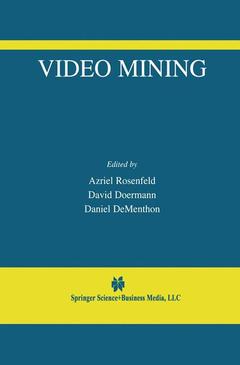Video Mining, Softcover reprint of the original 1st ed. 2003 The International Series in Video Computing Series, Vol. 6
Coordonnateurs : Rosenfeld Azriel, Doermann David, DeMenthon Daniel

Date de parution : 12-2010
Ouvrage de 340 p.
15.5x23.5 cm
Disponible chez l'éditeur (délai d'approvisionnement : 15 jours).
Prix indicatif 158,24 €
Ajouter au panierDate de parution : 08-2003
Ouvrage de 340 p.
15.5x23.5 cm
Thèmes de Video Mining :
Mots-clés :
Audio; Frames; information; multimedia; optical character recognition (OCR); production; video; video mining; video on demand



